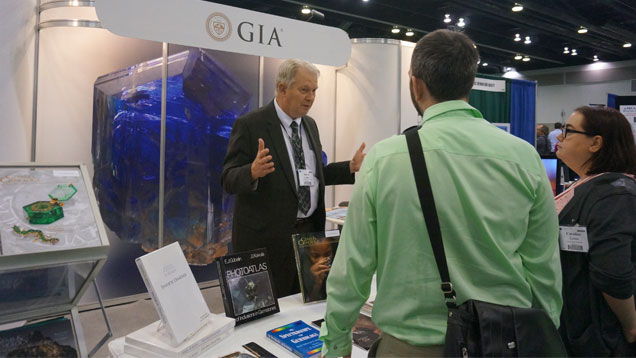Spotlight on Gemology at the Geological Society of America Annual Conference
December 10, 2014

But for GIA’s research team and other geoscientists who attended the Geological Society of America’s (GSA) annual meeting, it’s the science of gems that’s most fascinating.
The conference is one of the most respected in the geological science community and draws top researchers and noted academics – representing more than 50 countries – from around the world.
“It’s the meeting geoscience professionals and students attend,” Dr. James Shigley, GIA’s distinguished research fellow, said. In fact, nearly 40% of the roughly 6,700 attendees were undergraduate and graduate geoscience students.
“This conference enables the Institute to reach a new audience and share our research with other members of the scientific community,” he said. “It also provides an opportunity to expose geology students to gemology. We spoke with many who were interested in education programs and job opportunities at GIA in the geosciences field.”
Recognition of gemology as a field in the geosciences has increased in recent years, but many visitors to GIA’s booth were unfamiliar with the Institute, Shigley said.
“Our presence at the conference gave visitors the opportunity to learn more about who we are, what we do and the types of gemology positions available,” he added. “It was a chance for a face-to-face conversation with GIA researchers.”
Held Oct. 19-22 in Vancouver, British Columbia, Canada, the 2014 GSA conference included 346 technical sessions and 4,487 oral or poster presentations. Each half-day session was made up of brief presentations – on a related theme – by numerous professionals and students. GIA has had a booth at the conference for many years, but last year, the 125th anniversary of GSA, marked the first time the Institute hosted a half-day session. This year, GIA hosted back-to-back sessions – a full day of presentations.
GIA’s presentations emphasized the science of gems, including exploration, documenting the conditions of formation and characterizing the properties of gem minerals, and improving gem identification techniques. The sessions, titled “Gemological Research in the 21st Century: Exploration, Geology and Characterization of Diamonds and Other Gem Minerals,” included presentations from key GIA researchers including Dr. Wuyi Wang, Dr. Mike Breeding, Troy Ardon, along with Dr. Aaron Palke and Dr. Karen Smit, both postdoctoral research associates at GIA, as well as other renowned researchers and professionals in the geoscience community.
Shigley and Dona Dirlam, GIA’s director of the Richard T. Liddicoat Gemological Library and Information Center, moderated the presentations.
In addition to the sessions, GIA also hosted four gemological poster presentations on topics of Columbian emeralds, diamond inclusions and Sowerby’s “British Mineralogy,” illustrated volumes from the early 1800s. Each presenter, or group of presenters, created a poster of their research and were available to field questions from interested attendees.
GIA’s Vancouver alumni chapter hosted an event for local alumni to meet with researchers and speakers from the conference. More than 50 people gathered for the dinner reception on Oct. 20.
Dirlam, who has been involved with the GSA conference since 1980, understands the importance the meeting has to the scientific community and has been instrumental in GIA’s participation over the years. Not only is it important for GIA to learn about advancements in the geosciences, but it provides a forum to share gemological research, she said.
“Our involvement at this conference exposes the audience to what GIA researchers are doing day in and day out,” Dirlam said.



